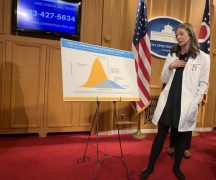Back in June, 19 state legislators joined together to claim that “Ohio smashed the curve long ago. Mission accomplished!”
Months later, as Ohio continues to set new records for COVID-19 cases and hospitalizations, one of those legislators admits the pandemic has proved to be an “evolving situation.” Another is doubling down on the letter’s message and suggests the data recent spike in cases may be inaccurate.
The letter’s author, state Rep. Craig Riedel of Defiance, concedes Ohio is now headed in the wrong direction — but still believes the governor needs to chart a different, more hands-off approach to handling the pandemic.
The virus is spreading all throughout the state, data from the Ohio Department of Health (ODH) shows, including in areas represented by lawmakers who argued in the June letter that the “peak of this crisis is far behind us.”
All 19 of these lawmakers are Republicans serving in the Ohio House of Representatives. Joining Riedel were Scott Wiggam of Wooster, Mark Romanchuk of Ontario, Tom Brinkman of Mt. Lookout, Phil Plummer of Dayton, J. Todd Smith of Farmersville, Reggie Stoltzfus of Minerva, George Lang of West Chester, Candice Keller of Middletown, Paul Zeltwanger of Mason, Dick Stein of Norwalk, John Becker of Union Twp., Kris Jordan of Ostrander, Darrell Kick of Loudonville, Rick Perales of Beavercreek, Jena Powell of Arcanum, Susan Manchester of Waynesfield, Riordan McClain of Upper Sandusky and Bill Reineke of Tiffin.
Of the 30 counties represented by letter signers, 12 are labeled as red on the ODH’s coronavirus advisory system — meaning they have “very high exposure and spread.” The other 18 are labeled in orange, designated as having “increased exposure and spread.” Brinkman’s home county of Hamilton was labeled in the most recent update as approaching the worst level, purple, designating “severe exposure and spread.”
Each week, the state also ranks Ohio’s 88 counties by their rank of virus occurrence (adjusted for population). Those that signed the June 3 letter collectively represent areas with higher average rates of occurrence than those represented by lawmakers who didn’t sign.
Auglaize County, represented in part by Riedel who wrote the letter, has the second-highest occurrence of COVID-19 as of this article’s publication.
The Ohio Capital Journal reached out to the offices of all 19 lawmakers who signed the letter to hear their reflections about it; whether their views have changed in the months since; and how they believe Ohio should best handle the virus in the months ahead. Four responded.
The letter, directed at Gov. Mike DeWine, argued “original projections” overestimated the impact of the virus and pointed to data showing that most deaths were linked to people living in long-term care facilities and nursing homes.
“Currently, our great State has an unemployment rate over 20%,” the letter continued, “and while it is fair to say that early on your decisions and actions saved lives, it is also fair to say that many more Ohioans have had their lives wrecked by the economic devastation caused by these government lockdowns. Ohioans no longer need, nor want, an overreaching government micromanaging their lives, and they want their freedoms and liberties restored now…not this summer or fall, but now!”
The letter concluded by urging DeWine to rescind all health orders and allow the state legislature to have a role in the “decision making process.” (The full letter text is included at the end of this article.)
In an interview, Riedel defended the letter in context with that point in the virus response. He remains critical of early projections that warned Ohio could see up to 10,000 new cases per day.
“I’ll never forget that,” Riedel said of the 10,000 figure. “I’ll never forget that. We never got close to that. Not even remotely close.”
No one blames the initial heavy response given the early fears, Wiggam said.
“It sounded like it was going to be apocalyptic,” he said.
Becker said that while he still disagrees with how DeWine handled the early days of the virus, “at least it made sense based on the unknowns we had at the time.”
Freedoms vs. virus mitigation
Statehouse opinions began to sour in April and May. The state did not see a spike as high as forecasters believed was possible, in part due to the proactive shutdown and because of limited testing capability at the time. Nor did Ohio make use of a field hospital set up at the Columbus Convention Center designed to aid local hospitals in the event of a surge.
Dr. Andrew Thomas, the chief clinical officer at the OSU Wexner Medical Center in Columbus, explained at a recent press conference that this type of overpreparation is by design.
“We all are taught to prepare for the worst-case scenario,” Thomas said, “whether it’s about any one individual patient or in this case a pandemic.”
Regardless, lawmakers began vocalizing their frustrations.
“Governor DeWine, hospitals are empty, the curve is flat, you did what was necessary early in this pandemic,” Rep. Dick Stein, R-Norwalk, wrote on Facebook in early May. “However, millions have been spent on convention centers and sports arenas that were converted to temporary hospitals based on faulty projections. These projections are now being used to deny the people of Ohio their personal freedoms, freedom to work, freedom from masks and freedom from a tyrannical state government controlling our lives.”
By the end of May, Ohio had recorded over 35,000 cases of COVID-19 and more than 2,100 deaths — nearly the average amount of yearly flu and pneumonia deaths reported in a matter of three months.
At that point, the stay-at-home order had been rescinded and DeWine had allowed most businesses in Ohio to reopen (with some restrictions still in place). Ohio continued to prohibit gatherings of over 10 people.
Some lawmakers viewed the crisis as being over, and with the major spike avoided they were eager to spike the football. Thus came the June 3 letter which began by proclaiming, “Mission accomplished!”
As testing ramped up during the summer, Ohio saw record new cases in July and daily rates hovered at around 1,000 cases recorded per day through September.
Things have only gotten worse in October. The state set a new record for most cases reported in a 24-hour span, with 1,840 new cases reported on Oct. 9. Three days later, the state topped 5,000 total deaths from the coronavirus in 2020.
A new daily case record was again set on Oct. 14, then again on Oct. 17, and three times more on Oct. 21, 23 and 24. More than 2,850 new cases were reported on that last date.
This increase in cases is also leading to record numbers of Ohioans being hospitalized due to the virus.
In a provided statement, Rep. Stein said things are different now than when he signed the June letter. He called the current statistics “troubling.”
“When I initially signed the letter and assessed the situation back in June, the numbers were a lot different,” Stein said. “Ohio was ahead of many other states as far as taking precautions and social distancing. This pandemic has proved to be an on-going and evolving situation with the numbers constantly changing. The recent spikes in Ohio, more specifically in Lorain and Huron counties, are troubling. However, I plan to continue working to find solutions to help all Ohioans return to some degree of normalcy in the future.”
Riedel and others are still largely focused on the issue of government overreach.

“My feelings have not changed one bit,” Riedel said.
The Defiance native still feels DeWine should rescind all health orders, quoting an oft-heard view that the “cure can’t be worse than the disease itself.” He pointed to increases in side consequences to the pandemic such as domestic violence, suicide and drug overdoses.
“(Ohioans) want their freedoms and liberties restored,” Riedel said. “They want the governor to trust them.”
Riedel said the “little bit of a surge in the past few weeks” was to be expected, with colder weather having more people congregate indoors.
“I don’t think anybody should be shocked at all or surprised by that,” he said of the increases in cases and hospitalizations.
Letter says ‘we definitely know how to behave around the virus,’ but few signers wear masks
Riedel said that by and large, his constituents are paying attention to the health guidelines such as wearing masks and staying socially distant.
“People in my district are not being rebellious,” Riedel said. “They’re listening to the governor, they’re being respectful of each other.”
One line from the June 3 letter states: “Being eleven weeks into this we definitely know how to behave around the virus and we know who needs the most protection from it.”
A review of social media activity shows few of the signers wear masks in public settings, such as campaign gatherings. One signer, Republican Candice Keller of Middletown, has openly flouted the health guidelines and said in July she was asked to leave a Gettysburg museum for not wearing a mask.
Speaking to the Capital Journal, Wiggam called the virus a “very discriminatory killer” and said the government should be focusing all its energy and resources on making sure nursing homes stay safe.
“The approach needs to be different,” Wiggam said. “Instead of fear mongering, we should focus on keeping those with comorbidities safe.” He argued the state should have taken a “herd immunity” approach during 2020.
In the Oct. 20 interview, Wiggam said Ohio was in good shape with its COVID-19 statistics. Informed the state had actually recorded a new high watermark for Ohioans hospitalized for the disease just a day before, Wiggam said he had not seen that data and contended the death rate remained low.
“There’s a lot of misconstrued data,” Wiggam said. “You’re not getting great research right now.”
Wiggam said he questions the COVID-19 numbers reported by health officials and believes the figures may be padded by false positives. He complimented State Auditor Keith Faber for conducting an audit of state coronavirus data. Faber’s office has declined to release any information about the audit to date.

Wiggam said he believes the virus is being politicized, and claimed the nation is only focused on the pandemic because Republicans control the White House.
“I saw this immediately as being a political issue,” he added.
Another signer, Becker from Clermont County, told the Capital Journal he’s “seeing a slightly upward trend line, but I’m not seeing anything alarming” in terms of virus statistics.
Becker, who is finishing his last term as state representative, is spearheading a campaign to get the governor impeached and arrested on charges of tyranny. Fellow letter signers Keller and Zeltwanger have endorsed his impeachment effort of DeWine.
“I think the governor should find some way to save face and get the state opened up as soon as possible and get back to normal,” Becker said, adding he thinks health orders should be left up to local health departments.
Looking forward
Riedel reiterated the letter’s call that the Ohio General Assembly should play a larger role in handling the pandemic. He supports Senate Bill 311, which would limit the state health director’s ability to issue statewide quarantine and isolation orders impacting those who are not sick or have been directly exposed. SB311 also allows the state legislature to rescind other health orders issued by the Ohio Department of Health.
The bill passed the Ohio Senate in September and Riedel said he hopes the bill gets considered by the Ohio House of Representatives after the upcoming election.
Wiggam said he is supportive of vaccine development, but quickly added he’s for “people having freedoms and liberties” to take or not take it.
In press conferences and speeches around the state, DeWine has repeatedly urged for Ohioans to heed the guidelines to slow the spread of the virus.
“It’s only a mask. It’s only a mask,” he said a week ago. “You know, we think of sacrifices that have been made by people for this country that have been huge. This is only a mask. And we’re just asking people to wear it.”
Dr. Thomas, with the Wexner Medical Center, offered an optimistic view of the troubling direction of Ohio.
“We’ve done this before,” he said. “We’ve bent the curve and kept this from becoming a worse problem than it’s been twice over the past seven months. And I’m sure the citizens of Ohio are up to the task again.”
Full text of June 3 letter signed by 19 lawmakers:
“Governor DeWine,
It is time to cancel the Stay-at-Home, Stay Safe Ohio and Ohioans Protecting Ohioans health orders. Ohio smashed the curve long ago. Mission accomplished! The original protections were terribly off the mark and overestimated the statistical impact of the coronavirus by a wide margin. The metrics following the virus indicate that the peak of this crisis is far behind us. It’s blatantly clear that the virus is most aggressively attacking the elderly and individuals with underlying health conditions. Approximately 70% of all of Ohio’s deaths related to the virus are people who lived in long term care facilities and nursing homes. Being eleven weeks into this we definitely know how to behave around the virus and we know who needs the most protection from it.
Currently, our great State has an unemployment rate over 20% and while it is fair to say that early on your decisions and actions saved lives, it is also fair to say that many more Ohioans have had their lives wrecked by the economic devastation caused by these government lockdowns. Ohioans no longer need, nor want, an overreaching government micromanaging their lives, and they want their freedoms and liberties restored now… not this summer or fall, but now!
As a co-equal part of Ohio government, it’s time again for the General Assembly to be reasserted into the decision making process and it’s time for you and your administration to trust Ohio with its future! We the undersigned and Members of the Ohio General Assembly respectfully demand that you rescind any and all current health orders pertaining to this pandemic immediately!”
***
Also from Ohio Capital Journal:
Commentary: In rural America, resentment over COVID-19 shutdowns is colliding with rising case numbers
As COVID-19 spreads through rural America, new infection numbers are rising to peaks not seen during this pandemic and pushing hospitals to their limits. Many towns are experiencing their first major outbreaks, but that doesn’t mean rural communities had previously been spared the devastating impacts of the pandemic.
Infection rates in rural and frontier communities ebbed and flowed during the first seven months, often showing up in pockets linked to meat packing plants, nursing homes or prisons.
Even if they had no cases, many rural areas were under statewide public health orders that left businesses closed and events canceled. And that has become part of the problem today. The early compassionate and cohesive community responses to COVID-19 quickly gave way to growing anger and compliance fatigue, especially when some isolated towns didn’t see their first positive cases until summer.
That resentment toward public health recommendations, including mask-wearing, is now on a crash course with rising case numbers in the Mountain West, Midwest and Great Plains. For the fifth week in a row, rural counties witnessed a sharp increase in cases, to the point where over 70% of the nation’s nonmetropolitan counties had earned a “red zone” designation, suggesting local viral spread was out of control. The reality, though, is COVID-19 has never been “under control” in the U.S. READ MORE
Former DHS official: Plot against Whitmer was ‘reminiscent’ of ISIS
Miles Taylor is one of several former President Trump administration senior officials who has now endorsed Democratic nominee Joe Biden.
Taylor served as chief of staff to former Department of Homeland Security (DHS) Secretary Kirstjen Nielsen and acting Secretary Chad Wolf from 2017 to 2019. Taylor joins Olivia Troye, a former coronavirus adviser to Vice President Mike Pence and Former DHS General Counsel John Mitnick in backing Biden.
“Given what I’ve experienced in the administration, I have to support Joe Biden for president,” he said in an August ad from the group Republican Voters Against Trump. “And even though I’m not a Democrat, even though I disagree on key issues, I’m confident that Joe Biden will protect the country. READ MORE





